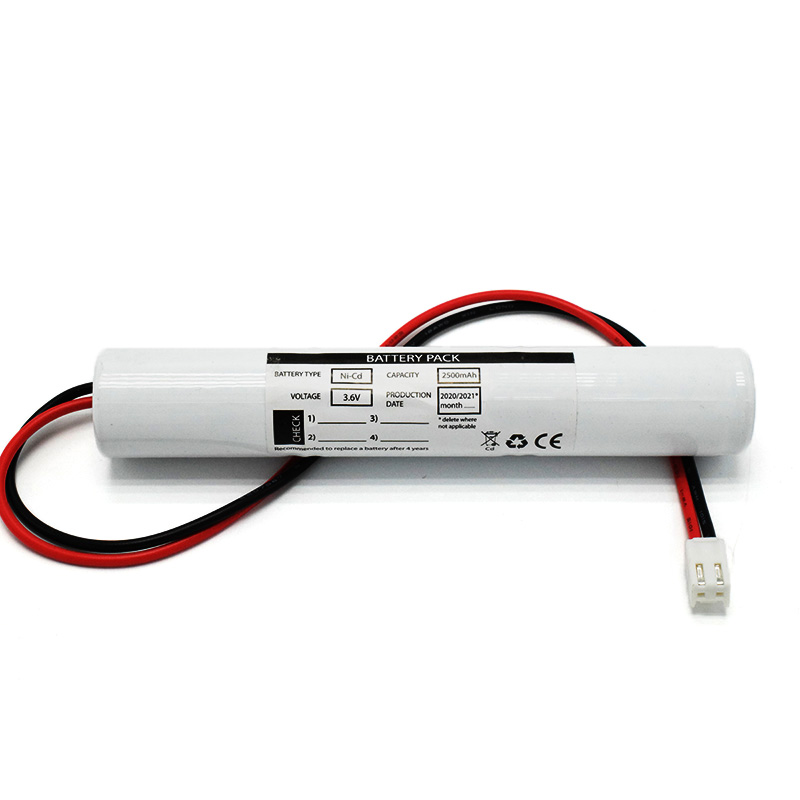Nickel-Cadmium (Ni-Cd) batteries are rechargeable. They are one of the oldest and most widely used rechargeable battery chemistries in the market. Ni-Cd batteries have been around since the early 1900s and are still used in a variety of applications today.
Ni-Cd Battery Pack C2500mAh 3.6V
Ni-Cd batteries are made up of a nickel oxide hydroxide cathode, a cadmium anode, and a potassium hydroxide electrolyte. When the battery is charged, electrons are forced into the anode, which converts the cadmium oxide into cadmium hydroxide. At the same time, the nickel oxide hydroxide in the cathode is converted into nickel oxyhydroxide. During discharge, the process is reversed, with the cadmium hydroxide in the anode being oxidized back into cadmium oxide, and the nickel oxyhydroxide in the cathode being reduced back into nickel oxide hydroxide.
The ability of Ni-Cd batteries to be recharged is due to the reversibility of this electrochemical reaction. When a NiCd battery is discharged, the cadmium oxide in the anode and the nickel oxide hydroxide in the cathode are converted into their respective hydroxides. When a charging voltage is applied, the opposite reaction occurs, and the hydroxides are converted back into their original forms.
Charging a Ni-Cd (Nickel Cadmium) battery requires following a few specific steps to ensure safe and effective charging. Here's a general guide on how to charge Ni-Cd batteries:
Make sure the battery is completely discharged before charging. This helps to prevent overcharging, which can damage the battery.
Connect the battery charger to a power source and check the charger's voltage setting. It should match the voltage rating of the Ni-Cd battery you're charging.
Attach the charger to the battery terminals, making sure the positive and negative terminals are correctly aligned.
Turn on the charger and monitor the battery's temperature during the charging process. Ni-Cd batteries can become hot when charging, so it's important to keep an eye on the battery's temperature and avoid charging it for too long.
When the battery is fully charged, disconnect the charger from the battery and power source.
It is worth noting that in order to avoid the "memory effect" of NiCd batteries, it is recommended that the batteries be completely discharged and then completely recharged at regular intervals, rather than partially recharging them several times.
One of the benefits of NiCd batteries is their ability to be recharged many times. They have a high cycle life, which means they can be charged and discharged repeatedly without losing their capacity to store energy. In fact, NiCd batteries can be recharged hundreds, if not thousands, of times. This makes them an excellent choice for applications where batteries are frequently used and need to be recharged often.
Another advantage of NiCd batteries is their high discharge rate. They can deliver a high current output, making them suitable for use in devices that require a lot of power, such as power tools and RC cars. NiCd batteries also have a low self-discharge rate, which means they can hold their charge for a long time, making them ideal for applications where the battery may not be used for extended periods.
For more information, please contact us. We will provide professional answers.

 Ni-MH Battery C4700mAh 3.6V
Ni-MH Battery C4700mAh 3.6V Nickel Cadmium Nicd Battery Pack SC1800mAh 3.6V
Nickel Cadmium Nicd Battery Pack SC1800mAh 3.6V Ni-Cd Battery Pack D4000mAh 3.6V
Ni-Cd Battery Pack D4000mAh 3.6V Ni-Cd Battery Pack C2500mAh 3.6V
Ni-Cd Battery Pack C2500mAh 3.6V NICAD Battery Pack AA900mAh 3.6V
NICAD Battery Pack AA900mAh 3.6V LiFePO4 IFR18650 1600mAh 3.2V
LiFePO4 IFR18650 1600mAh 3.2V LiFePO4 IFR18650 1600mAh 6.4V
LiFePO4 IFR18650 1600mAh 6.4V Ni-MH Battery C4000mAh 3.6V
Ni-MH Battery C4000mAh 3.6V E-bike Battery 48V 10Ah JL-1
E-bike Battery 48V 10Ah JL-1 E-bike battery 48V 10Ah Qing Tian
E-bike battery 48V 10Ah Qing Tian